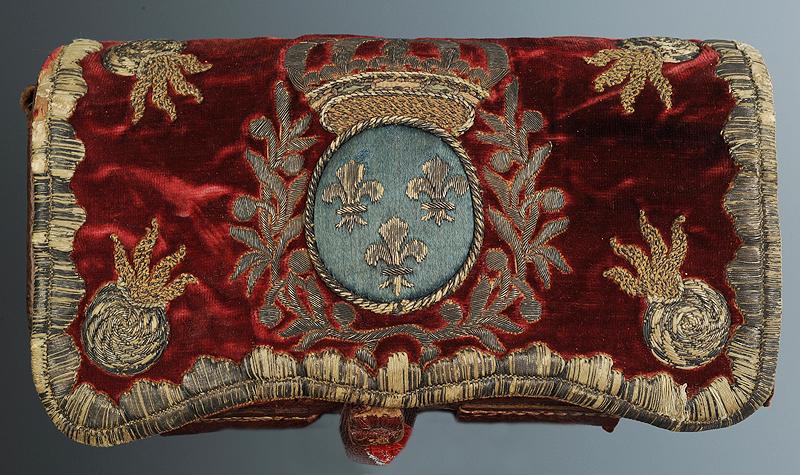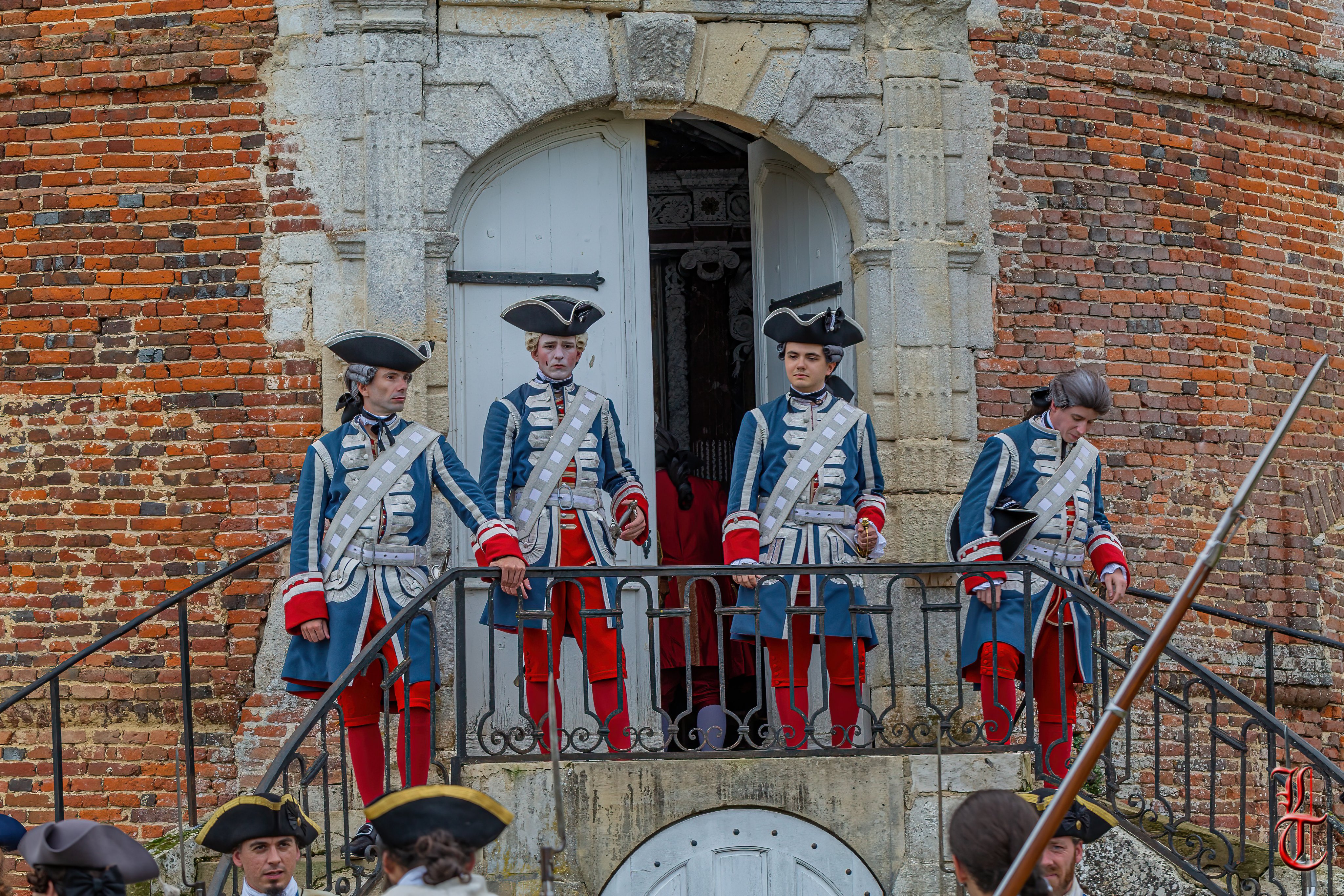The king's immense household was divided into three distinct branches: the civilian household, the ecclesiastical household and the military household. Of these, the military household was definitely the largest household with nearly 10.000 men serving in the king's personal service.
It was during the reign of Louis XIV that the king's military household was given a new purpose. It was transformed from having the sole purpose of protecting the royal family to also adopting the status of an elite fighting force. Its ranks were filled with the most experienced, professional soldiers whom the king could use for particularly difficult campaigns.
Over the centuries, the military household was expanded until it reached its final form of eight units: the gardes du corps, the French guards, the gendarmes, the Swiss guards, the musketeers, the grenadiers, the gentilhommes à Bec de Corbin and the chevau-légers:
The Gardes du Corps
The royal family's private lifeguard was divided into four companies: Garde Écossaise (Scottish Guards), 1st French Company, 2nd French Company and 3rd French Company. Surprisingly, the Scottish Guards were considered to be the highest-ranking within the royal bodyguards.
Of the men in the Scottish Guards, the 24 oldest formed the Gardes de la Manche - they were so-named because they infamously stood so close to the king that they touched his sleeves (manches).
The royal bodyguards were exclusively aristocratic which inevitably led to companies more renowned for their aristocratic virtues than their military expertise. Throughout their existence, they were the target of critics who pointed out that they contributed very little to the army's actual fighting and always embarrassed themselves when they finally did go on campaign. Frankly, the criticism was not entirely unfounded. For instance, they were so outraged at having to wear a uniform at court that they eventually "won" the right to wear their civilian clothing while at court.
The sheer size of the royal bodyguards rose massively during the age of Versailles. Originally, they had been 400 but were increased to 1.600 by Louis XIV before Louis XV decreed that each company was to have 320 men divided into two squadrons and six brigades.
 |
| A gate guard (left) and bodyguard (right) during Louis XIV |
The French Guards
The most prestigious infantry unit in the king's service was also the oldest. Created a century before, in 1560, the French guard were deployed for no less than 20 conflicts until their final dissolution in 1789. From 1646, the French Guards were divided into 30 regiments of widely different sizes in manpower; some employed 20 while others held 200. The head of the unit was a colonel-general.
It was they, alongside the Swiss Guards, who controlled the entrance to the palace. Therefore, it fell to them to lock and secure the numerous gates leading into the palace. Traditionally, the French and Swiss guards divided the courtyard immediately before the palace in two; each guard would be responsible for its own side. Dressed in blue, the French Guards were easy to distinguish from their red-clad, Swiss colleagues.
While on duty at Versailles, they would be housed in barracks. However, neither them nor the Swiss Guards were permanently garrisoned at Versailles. Instead, the French had their headquarters in Paris whereas the Swiss' were located in Rueil. From there each corps would dispatch the required number of guards.
The Swiss Guards
 |
| Officer and soldier in the Swiss Guard, 1757 |
Gendarmes
Ranking second within the hierarchy of the military household, the gendarmes - literally "men of arms" - was created in 1609 for the purpose of guarding the then-dauphin, the future Louis XIII. Their charge would later officially integrate them into the king's household.
Traditionally, it was filled by men of the nobility - although access for others was not outright reserved by law. Officially, the king was the head of the gendarmes although he outsourced the daily management of the regiment to a captain-lieutenant.
Despite their high placement within the military household, they would not survive the reform of the late 1780's. By this time, the military household was far to expensive compared to the services they rendered which forced Louis XVI to disband them in 1787.
Musketeers
Undoubtedly the more famous of the regiments - particularly thanks to The Three Musketeers by Dumas - the musketeers were originally in the service of Cardinal Mazarin. They entered royal service in 1660 when the king absorbed the cardinal's troop. Up until then, they had had a tumultuous, albeit brief, history. Established in 1622, they were disbanded again in 1646-1657, before finally merging with the king's own soldiers.
The musketeers were a mounted infantry regiment which was divided into two companies. During Louis XV these held 500 men combined. By 1775, Louis XVI disbanded the regiments but they were amongst the first to be revived during the Restoration.
 |
| Evolution of the musketeers |
Chevau-Légers
Established in 1593, the regiment - translated into "Light Horse" - counted 200 men. This was the only unit in the king's household which was made up entirely of aristocrats who would otherwise possess various ranks of officer in the king's army.
Having become too expensive to justify, the Light Horse was disbanded in 1787 by Louis XVI.
 |
| An officer in the Light Horse |
Gentilhommes à Bec de Corbin
These two regiments were named for their primary weapon: the halberd. The particularly type of halberd they used happened to be shaped like the beak of a bird - hence the name "Bec de Corbin". They were briefly disbanded during Louis XIII before being reinstated by Louis XIV.
At official processions, they walked two-by-two in front of the king. By 1683 they numbered 100 men; eventually, they would be integrated into the king's private bodyguard as the 2nd French Guards.
Mounted Grenadiers
The latest addition to the military household was added by Louis XIV in 1676. Like the musketeers, they were a mounted regiment whose primary purpose was to assist in sieges. The conflicts in which France had participated hitherto had been marked by immensely bloody sieges which inevitably led to considerable losses for the king's other regiments. By deploying this specialised unit alongside the king's bodyguards and musketeers, the latter two would avoid nearly as many casualties.
Technically, the Mounted Grenadiers fell under the administration of the king's bodyguard. The Battle of Leuze in 1691 was the turning-point in the regiment's history. Having distinguished themselves, the king rewarded them by a considerable increase in both soldiers and officers - and their own standard. Originally, there had been 74 men in the regiment - led by a captain-lieutenant - but they were increased to 150.
By the 1770's, the Crown's finances were desperate which caused Louis XVI to finally suppress the Mounted Grenadiers in 1776.
 |
| Pouch belonging to an officer in the mounted grenadiers, 1740's |
It should be pointed out that not everyone was in service at the same time - for instance, the king's garde de corps served in intervals of a yearly quarter. This meant that for three quarters of the year, most of the king's guardsmen were away from court. This presented both a problem and an opportunity. Such a large number of unemployed soldiers could become a problem but fortunately there was always a considerable building project somewhere which might need a few hundred hands. Thus, men from the king's military household were routinely dispatched for various projects including the aqueduct through the estate of Maintenon or the Swiss Lake (named for the men who dug it and whose regiment had protected the French kings for centuries). On occasion, more soldiers would be recruited for special occasions such as royal weddings where increased security was needed.
While on duty, they would typically be housed in barracks erected in various locations around the ever-growing city of Versailles, including new facilities erected in 1773 at the Place d'Armes.
Over the years, the elite forces established by Louis XIV declined significantly. During the War of the Austrian Succession, the discipline - and lack of competent leadership - caused the deployed regiments to panic and retreat on numerous occasions. Such ignominy meant that Louis XV kept every single regiment out of the following Nine Years' War.
One of the leading factors behind such a rapid decline was, as stated, the lack of leadership. The age of Louis XIV had seen brilliant commanders including Turenne and the Grand Condé but as the officer class became more restricted to the sons of the nobility, entire regiments would be handed down as part of an inheritance from father to son. Thus, many very young noblemen were put in charge of regiments without having any experience with either command or military service outside the royal academies. Over the decades, the sphere of eligible men for officers' posts became increasingly restricted. Louis XV further tightened the noose by demanded four generations of nobility on the father's side with the sole exception being the sons of chevaliers de Saint-Louis.
 |
| Re-enactors (@maisonmiliduroi) |
Furthermore, like all other posts at court, the position of officer in a royal regiment was venal. It therefore became a matter of who could afford to purchase a commission regardless of competence. Such places were anything but cheap. The richest families bought and sold their places for up to 500.000 livres while the post of lieutenant in the gendarmes cost about 120.000 livres by the early 1770's. This effectually placed another hurdle for anyone not of aristocratic descent. As if such exorbitant prices were not discouraging enough, the king placed heavy taxes on the sale of commissions.
Besides the accusations of incompetence raised against the military household, there was an increased influx of luxury - even on campaign. Already during Louis XIV, the officers were criticised for bringing their courtly habits along when waging war. This included large households complete with lackeys and personal chefs.
By the 1770's, the finances were dire and the Comte de Saint-Germain was tasked with coming up with new ways of retrenching. He immediately focused on the king's largest household whose numbers had only increased just as their prestige was declining. Consequently, many of the regiments within the king's military household were suppressed as superfluous. This immediately made the Comte the enemy of most of the court as his original plans had envisioned the abolishing of about 2.700 officer posts within the aristocracy. Eventually, the opposition became so great that Louis XVI had to agree to less stringent measures - however, these still saw the disbanding of a large part of his military household.
It is tempting to raise the question of whether the royal family would have been forcibly removed to Versailles in 1789 if the household had been kept intact. Yet, the fact that the French Guards were amongst the first to join the revolutionary cause would seem to argue against such stance. In an ironic twist of fate, it was not the celebrated French guard who stood between the king and the revolutionary fury - it was his Swiss soldiers.
